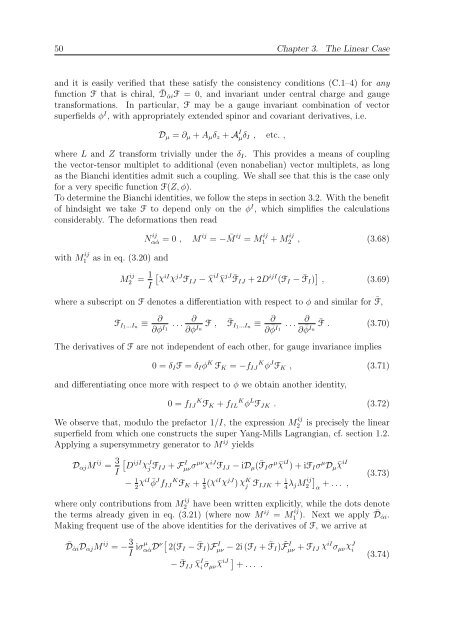N=2 Supersymmetric Gauge Theories with Nonpolynomial Interactions
N=2 Supersymmetric Gauge Theories with Nonpolynomial Interactions
N=2 Supersymmetric Gauge Theories with Nonpolynomial Interactions
You also want an ePaper? Increase the reach of your titles
YUMPU automatically turns print PDFs into web optimized ePapers that Google loves.
50 Chapter 3. The Linear Case<br />
and it is easily verified that these satisfy the consistency conditions (C.1–4) for any<br />
function F that is chiral, ¯ D ˙αiF = 0, and invariant under central charge and gauge<br />
transformations. In particular, F may be a gauge invariant combination of vector<br />
superfields φ I , <strong>with</strong> appropriately extended spinor and covariant derivatives, i.e.<br />
Dµ = ∂µ + Aµδz + A I µδI , etc. ,<br />
where L and Z transform trivially under the δI. This provides a means of coupling<br />
the vector-tensor multiplet to additional (even nonabelian) vector multiplets, as long<br />
as the Bianchi identities admit such a coupling. We shall see that this is the case only<br />
for a very specific function F(Z, φ).<br />
To determine the Bianchi identities, we follow the steps in section 3.2. With the benefit<br />
of hindsight we take F to depend only on the φ I , which simplifies the calculations<br />
considerably. The deformations then read<br />
<strong>with</strong> M ij<br />
1 as in eq. (3.20) and<br />
N ij<br />
α ˙α = 0 , M ij = − ¯ M ij = M ij<br />
1 + M ij<br />
2 , (3.68)<br />
M ij<br />
2 = 1 <br />
χiIχ I<br />
jJ FIJ − ¯χ iI ¯χ jJ FIJ<br />
¯ + 2D ijI (FI − ¯ FI) , (3.69)<br />
where a subscript on F denotes a differentiation <strong>with</strong> respect to φ and similar for ¯ F,<br />
FI1...In ≡ ∂ ∂<br />
. . . I1 ∂φ ∂φIn F , ¯ FI1...In ≡ ∂<br />
∂ ¯ φI1 . . . ∂<br />
∂ ¯ φ In<br />
¯F . (3.70)<br />
The derivatives of F are not independent of each other, for gauge invariance implies<br />
0 = δIF = δIφ K FK = −fIJ K φ J FK , (3.71)<br />
and differentiating once more <strong>with</strong> respect to φ we obtain another identity,<br />
0 = fIJ K FK + fIL K φ L FJK . (3.72)<br />
We observe that, modulo the prefactor 1/I, the expression M ij<br />
2 is precisely the linear<br />
superfield from which one constructs the super Yang-Mills Lagrangian, cf. section 1.2.<br />
Applying a supersymmetry generator to M ij yields<br />
DαjM ij = 3 <br />
D<br />
ijIχ<br />
I<br />
J j FIJ + F I µνσ µνχiJ FIJ − iDµ( ¯ FIσ µ ¯χ iI ) + iFIσ µ Dµ ¯χiI<br />
− 1<br />
2 χiI ¯ φ J fIJ K FK + 1<br />
3 (χiIχjJ ) χK j FIJK + i<br />
4<br />
ij<br />
λjM2 + . . . ,<br />
α<br />
(3.73)<br />
where only contributions from M ij<br />
2 have been written explicitly, while the dots denote<br />
the terms already given in eq. (3.21) (where now M ij = M ij<br />
1 ). Next we apply ¯ D ˙αi.<br />
Making frequent use of the above identities for the derivatives of F, we arrive at<br />
¯D ˙αiDαjM ij = − 3<br />
I iσµ<br />
α ˙α Dν 2(FI − ¯ FI)F I µν − 2i (FI + ¯ FI) ˜ F I µν + FIJ χiI σµν χJ i<br />
− ¯ FIJ ¯χI<br />
i ¯σµν ¯χiJ + . . . .<br />
(3.74)

















